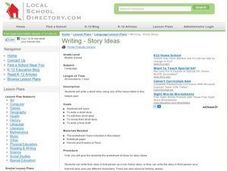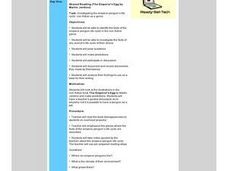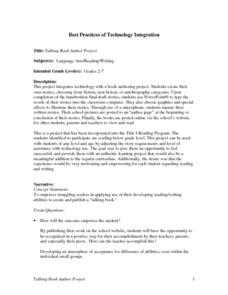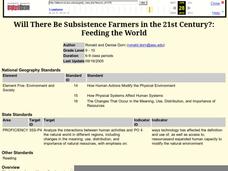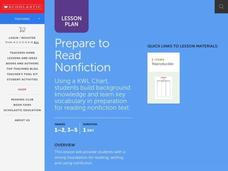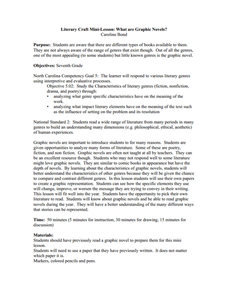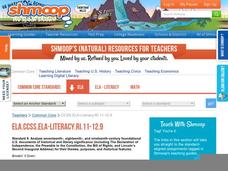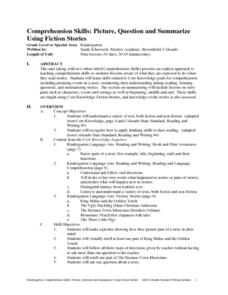Curated OER
Writing - Story Ideas
Middle schoolers write their story in first person as a non-fiction story, or they can write the story in third person as a fictional story and use different characters. They can choose an idea from one of the story starters provided.
Curated OER
Tall Tales: Read, Write, Draw and Sing
Students get to know the characters and events that shaped American folktales through writing, drawing and singing activities. Handouts and worksheets are included.
Curated OER
The Emperor's Egg by Martin Jenkins
Students explore the penguin life cycle. In this penguin life cycle lesson, students read the book The Emperor's Egg by Martin Jenkins. Students look at the pictures and make predictions. Students identify facts about penguins and do...
Curated OER
Different Genres In Literature
Third graders view different genres of literature and identify which genre is being presented to them. In this genres lesson plan, 3rd graders choose from fiction, non fiction, and a poem.
Curated OER
Talking Book Author Project
Students explore fiction, non-fiction, and autobiographies. They create their own stories using one of the categories. Students create a PowerPoint presentation to tell their story.
PBS
Reading Adventure Pack: Folktales
Following a reading and thorough discussion of books—Anansi the Spider: A Tale from the Ashanti by Gerald McDermott and The Moon Book by Gail Gibbons—scholars complete three activities. First, they use playdough or cookie dough to create...
Curated OER
Will There Be Subsistence Farmers in the 21st Century?: Feeding the World
Students examine the topic of subsistence farming. They research the future of subsistence agriculture, identify the types and locations of subsistence agriculture, and write about subsistence farming in regards to developing nations and...
Curated OER
Learning About Evaluation
Students evaluate the essays of their classmates. In this evaluation lesson, students write two non-fiction essays on two different topics that they may choose. After a lecture on the aspects of the paper that will be evaluated,...
Curated OER
Tango Stories
Students listen to tango music and research the country it came from. In this music instructional activity, students find that tango music comes from Argentina. They listen and dance to the music and then write stories.
Curated OER
How-To Books
Students apply their knowledge and create a how-to book of their own. In this early childhood language arts worksheet, students learn about non-fiction books and write their own procedural non-fiction booklets.
Curated OER
Prepare to Read Nonfiction
Students get an introduction to using KWL Charts as tools for reading nonfiction. They study unfamiliar words and share what they already know about the topic of the non-fiction selection and use this knowledge to help prepare to read.
Curated OER
Summarizing and Mapping for Comprehension
Students practice summarization in order to increase their comprehension of non-fiction text. They read and summarize passages by finding the main ideas in passages from a Social Studies textbook. After silently reading the passage they...
Curated OER
Discovering the Deep
Students explore the world's oceans. They research questions about the oceans and write a research report about an ocean animal. Students identify at least four different writing genres they experienced while reading about the ocean.
Curated OER
Stick To The Topic
Second graders engage in a lesson that is concerned with the increase of writing conventions. The teacher models the writing process for the students. The students work with the teacher to create a shared writing piece before the work...
Curated OER
Autobiography
Sixth graders read and write autobiographical sketches, determine the author's purpose in writing, and type paragraphs using WP utilities.
Curated OER
"Spelldown" by Becky Mushko
Learners read Spelldown, by Becky Mushko and consider how it portrays the Appalachian community. They define and discuss vocabulary presented in the story and write a comparison/contrast paper analyzing two of the story's characters. The...
Appalachian State University
What Are Graphic Novels?
To do this engaging and pleasurable activity, your learners should have already read a graphic novel, and produced a piece of writing that can be reproduced into the format of a graphic novel. This exercise provides a script that...
Curated OER
I am Special and You are Special Too - Project Children L.E.A.D.
Eighth graders recognize what makes them special through class participation and discussion of rap music, writing a poem about themselves, and designing their own special hat while working in groups.
Shmoop
ELA.CCSS.ELA-Literacy.RI.11-12.9
Guided by close-reading questions, groups examine the similarities and differences between the Declaration of Independence and the Bill of Rights. In addition, they look at how the principles are presented in these two foundational US...
Curated OER
Library Skills: Biography
Biographies deserve special attention when training youngsters how to use the library because they are alphabetized by subject rather than by author. Guide children through the process of finding biographies over a two-visit series. On...
Curated OER
The Life And Times Of The Apple
Learners engage in a study about the biology of apples that includes growth and reproduction. They conduct research using a variety of resources. Students write a description of an apple brought to class by answering several questions....
Curated OER
Researching Lesson 4
Students explore a "table of contents." For this book researching lesson, students identify common elements of a "table of "contents" and complete a worksheet with questions about this topic.
Shmoop
ELA.CCSS.ELA-Literacy.RI.11-12.7
Comparing information found in images, charts, and graphs with that found in written text can be a challenge for even senior high scholars. Provide learners with an opportunity to practice this skill with an exercise that asks them to...
Curated OER
Comprehension Skills: Picture, Question and Summarize Using Fiction Stories
Students build a variety of comprehension skills through the nine lessons of this unit. Picturing events, monitoring understanding during reading, forming questions, and summarizing stories form the core of the lessons being taught...


